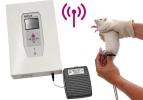Authors
NR Reed, WR Reed, M Syrett et al
Lab
University of North Carolina at Chapel Hill, Chapel Hill, NC, USA
Journal
Behavioural Brain Research
Abstract
Low back pain (LBP) is a major global burden in part due to the underlying pathophysiological mechanisms being poorly understood. A LBP rat model involving two injections of nerve growth factor (NGF, an endogenous pain-related neurotrophin) into trunk musculature was recently developed. Additional behavioral work in this NGF-LBP rat model is required to better characterize local and remote somatosensory alterations related to NGF-induced peripheral and central sensitization. This work characterizes the time-dependent development of hypersensitivity to trunk and hindpaw cutaneous mechanical stimulation and deep muscle mechanical hyperalgesia in adult male Sprague-Dawley rats (n=6/group). Behavioral assays were performed at baseline (Day 0, D0), D2, D5 (pre- and 4 hours post-2nd NGF or control injection), D7, D10, and D14 in NGF and control groups. Trunk and hindpaw cutaneous mechanical hypersensitivity were tested using von Frey filaments. Deep trunk mechanical hyperalgesia was determined using a small animal algometer. NGF rats demonstrated increased cutaneous sensitivity to ipsilateral trunk mechanical stimuli at D7, D10, and D14. NGF rats also demonstrated ipsilateral deep mechanical hyperalgesia on D2, D5 +4 h, D7, D10, and D14. Cutaneous hypersensitivity was delayed compared to deep hyperalgesia in NGF rats. No additional sensory changes were noted. Together, these results indicate that male mechanical somatosensory changes develop primarily locally in the ipsilateral trunk following unilateral NGF injections. These findings contrast with a previous report in female rats using this NGF-LBP model showing more widespread (bilateral) hyperalgesia and remote mechanical hypersensitivity. Future studies will examine potential sex-related pain behavioral differences in the NGF model.
BIOSEB Instruments Used:
SMALGO: SMall animal ALGOmeter (BIO-SMALGO)

 Douleur - Allodynie/Hyperalgésie Thermique
Douleur - Allodynie/Hyperalgésie Thermique Douleur - Spontanée - Déficit de Posture
Douleur - Spontanée - Déficit de Posture Douleur - Allodynie/Hyperalgésie Mécanique
Douleur - Allodynie/Hyperalgésie Mécanique Apprentissage/Mémoire - Attention - Addiction
Apprentissage/Mémoire - Attention - Addiction Physiologie & Recherche Respiratoire
Physiologie & Recherche Respiratoire
 Douleur
Douleur Système Nerveux Central (SNC)
Système Nerveux Central (SNC)  Neurodégénérescence
Neurodégénérescence Système sensoriel
Système sensoriel Système moteur
Système moteur Troubles de l'humeur
Troubles de l'humeur Autres pathologies
Autres pathologies Système musculaire
Système musculaire Articulations
Articulations Métabolisme
Métabolisme Thématiques transversales
Thématiques transversales SFN2024: Venez rencontrer notre équipe sur le stand 876 à Chicago
SFN2024: Venez rencontrer notre équipe sur le stand 876 à Chicago 